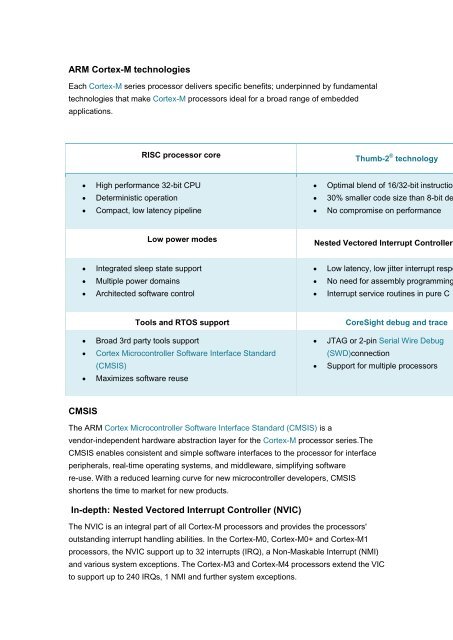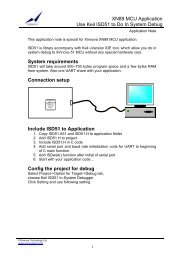ARM Cortex-M technologies CMSIS In-depth: Nested ... - Xinnova
ARM Cortex-M technologies CMSIS In-depth: Nested ... - Xinnova
ARM Cortex-M technologies CMSIS In-depth: Nested ... - Xinnova
You also want an ePaper? Increase the reach of your titles
YUMPU automatically turns print PDFs into web optimized ePapers that Google loves.
<strong>ARM</strong> <strong>Cortex</strong>-M <strong>technologies</strong><br />
Each <strong>Cortex</strong>-M series processor delivers specific benefits; underpinned by fundamental<br />
<strong>technologies</strong> that make <strong>Cortex</strong>-M processors ideal for a broad range of embedded<br />
applications.<br />
RISC processor core<br />
� High performance 32-bit CPU<br />
� Deterministic operation<br />
� Compact, low latency pipeline<br />
Low power modes<br />
� <strong>In</strong>tegrated sleep state support<br />
� Multiple power domains<br />
� Architected software control<br />
Thumb-2 ® technology<br />
� Optimal blend of 16/32-bit instruction<br />
� 30% smaller code size than 8-bit de<br />
� No compromise on performance<br />
<strong>Nested</strong> Vectored <strong>In</strong>terrupt Controller<br />
� Low latency, low jitter interrupt respo<br />
� No need for assembly programming<br />
� <strong>In</strong>terrupt service routines in pure C<br />
Tools and RTOS support CoreSight debug and trace<br />
� Broad 3rd party tools support<br />
� <strong>Cortex</strong> Microcontroller Software <strong>In</strong>terface Standard<br />
(<strong>CMSIS</strong>)<br />
� Maximizes software reuse<br />
<strong>CMSIS</strong><br />
The <strong>ARM</strong> <strong>Cortex</strong> Microcontroller Software <strong>In</strong>terface Standard (<strong>CMSIS</strong>) is a<br />
� JTAG or 2-pin Serial Wire Debug<br />
(SWD)connection<br />
vendor-independent hardware abstraction layer for the <strong>Cortex</strong>-M processor series.The<br />
� Support for multiple processors<br />
<strong>CMSIS</strong> enables consistent and simple software interfaces to the processor for interface<br />
peripherals, real-time operating systems, and middleware, simplifying software<br />
re-use. With a reduced learning curve for new microcontroller developers, <strong>CMSIS</strong><br />
shortens the time to market for new products.<br />
<strong>In</strong>-<strong>depth</strong>: <strong>Nested</strong> Vectored <strong>In</strong>terrupt Controller (NVIC)<br />
The NVIC is an integral part of all <strong>Cortex</strong>-M processors and provides the processors'<br />
outstanding interrupt handling abilities. <strong>In</strong> the <strong>Cortex</strong>-M0, <strong>Cortex</strong>-M0+ and <strong>Cortex</strong>-M1<br />
processors, the NVIC support up to 32 interrupts (IRQ), a Non-Maskable <strong>In</strong>terrupt (NMI)<br />
and various system exceptions. The <strong>Cortex</strong>-M3 and <strong>Cortex</strong>-M4 processors extend the VIC<br />
to support up to 240 IRQs, 1 NMI and further system exceptions.
Most of the NVIC settings are programmable. The configuration registers are part of the<br />
memory map and can be accessed as C pointers. The <strong>CMSIS</strong> library also provided<br />
various helper functions to make interrupt control easier.<br />
<strong>In</strong>side the NVIC, each interrupt source is assigned an interrupt priority. A few of the<br />
system exceptions like such as NMI haves a fixed priority level, and others hashave<br />
programmable priority levels. By assigning different priorities to each interrupt, the NVIC<br />
can support <strong>Nested</strong> <strong>In</strong>terrupts automatically without any software intervention.<br />
The architecture provides 8-bits of priority level settings for each programmable interrupt<br />
or exception. To reduce gate count, only parts of these registers are implemented. <strong>In</strong> the<br />
<strong>Cortex</strong>-M0, <strong>Cortex</strong>-M0+ and <strong>Cortex</strong>-M1 processors (<strong>ARM</strong>v6-M architecture), 4<br />
programmable levels are provided. <strong>In</strong> the <strong>Cortex</strong>-M3 and <strong>Cortex</strong>-M4 processors<br />
(<strong>ARM</strong>v7-M architecture), the designs allow from 8 priority levels to 256 levels.
To make the <strong>Cortex</strong>-M processors easier to use, the <strong>Cortex</strong>-M processor uses a stack<br />
based exception model. When an exception takes place a number of registers are pushed<br />
on to the stack. These registers are restored to their original values when the exception<br />
handler completes. This allows the exception handlers to be written as normal C functions,<br />
and also reduce the hidden software overhead ofin interrupt processing.<br />
<strong>In</strong> addition, the <strong>Cortex</strong>-M processors use a vector table that contains the address of the<br />
function to be executed for eacha particular interrupt handler. On accepting an interrupt,<br />
the processor fetches the address from the vector table. Again, this avoids software<br />
overhead and reduces interrupt latency.<br />
Various optimization techniques are also used in the <strong>Cortex</strong>-M processor<br />
implementationss to make interrupt processing more efficiency and make the system<br />
more responsive:<br />
Tail chaining – If another exception is pending when an ISR exits, the processor does not<br />
restore all saved registers from the stack and instead moves on to the next ISR. This<br />
reduces the latency when switching from one exception handler to another.<br />
Stack pop pre-emption – If another exception occurs during the unstacking process of<br />
an exception, the processor abandons the stack Pop and services the new interrupt
immediately as shown above. By pre-empting and switching to the second interrupt<br />
without completing the state restore and save, the NVIC achieves lower latency in a<br />
deterministic manner.<br />
Late arrival – If a higher priority interrupt arrives during the stacking of a lower priority<br />
interrupt, the processor fetches a new vector address and processes the higher priority<br />
interrupt first.<br />
With these optimizations, the interrupt overhead reduces as the interrupt loading<br />
increases, allowing high interrupt processing throughput in embedded systems.<br />
**Get more on <strong>ARM</strong> Webs:<br />
http://www.arm.com/products/







